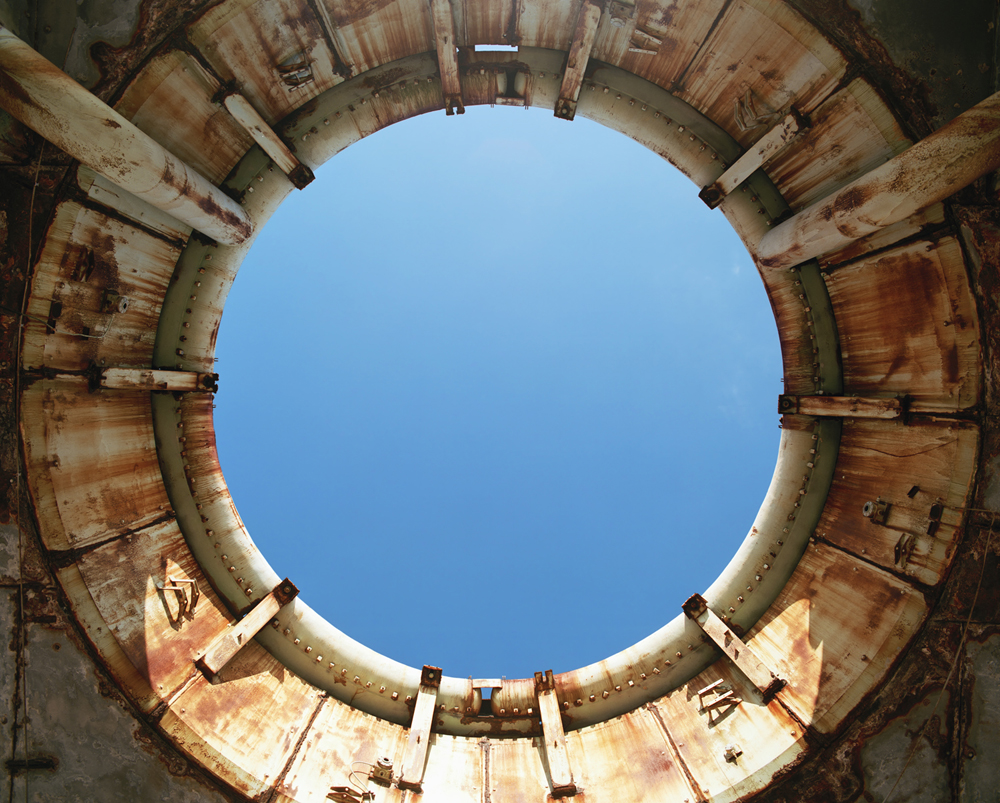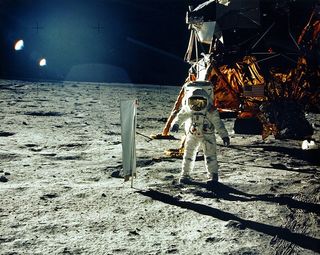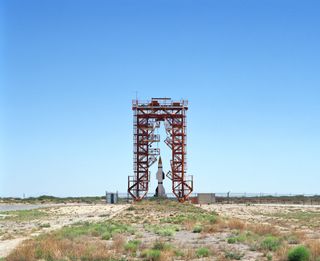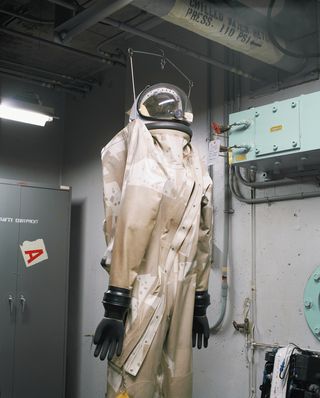
Abandoned Awe: Old Space Sites Should Inspire Exploration (Op-Ed)

Roland Miller is the dean of Communication Arts, Humanities, and Fine Arts at the College of Lake County in Grayslake, Illinois. Miller has been photographing the United States space program for more than 25 years. He contributed this article to Space.com's Expert Voices: Op-Ed & Insights.
Ray Bradbury wrote three "Abandon in Place" elegies after visiting the deactivated launch pads on Cape Canaveral Air Force Station in Florida. The first begins:
"Abandon in Place.
No Further Maintenance Authorized.
Abandon. Turn away your face.
No more the mad high wanderings of thought
You once surmised. Let be!
Wipe out the stars. Put out the skies."
(Copyright 1981 by Ray Bradbury)
The phrase "Abandoned in Place" is stenciled on many of the remaining structures located on Cape Canaveral's historic launch pads. This poignant phrase is meant to indicate that the facility it describes is no longer being maintained. This is the military's way of excusing the deteriorating conditions of facilities that are no longer in use. No commander wants to get docked on an inspection for failing to maintain unused and dated structures. [Stunning, Tragic Images of Abandoned Space History (Photos )]
The irony in that label is it precisely describes the United States' abandonment of extraorbital space exploration by humans after the Apollo program. "Abandoned in Place" also points to the public's loss of interest in such exploration after the first few moon-landing missions, the ultimate "been there, done that" story.

So what made the nation's attention drift from what was arguably one of the greatest, most momentous technological feats in history? The achievement appears even more impressive when viewed from nearly a half-century later, when the United States would have difficulty duplicating the accomplishment of landing humans on the moon and returning safely to Earth within the nine-year window President John F. Kennedy proposed in 1961. It was this question, and others, that intrigued me when I began photographically documenting and interpreting the deactivated, abandoned and repurposed launch and test facilities that allowed the United States to reach the moon. [40 Years After Moon Landing: Why Is It So Hard to Go Back?]

Finding what was lost
In 1988, I was teaching photography at nearby Brevard Community College, now Eastern Florida State College, when I first visited Launch Complex 19. I was assisting an environmental engineer in properly disposing of some old photographic chemicals on Cape Canaveral Air Force Station. When I expressed to him how exciting it was to be on Cape Canaveral, he offered to show me the Complex 19 site.
Get the Space.com Newsletter
Breaking space news, the latest updates on rocket launches, skywatching events and more!
All of the manned Gemini-Titan missions were launched from Complex 19. This abandoned and deteriorating launch pad immediately struck me, and I knew I wanted to photograph the structures there. My engineer escort told me there were other abandoned pads on Cape Canaveral; little did I know at the time how many launch sites, rocket-engine test stands, wind tunnels and other facilities related to early space exploration I would visit in my quest to preserve these sites through photography.
The images produced during the nearly 25 years of this project culminated in a book, "Abandoned in Place: Preserving America's Space History" (UNM Press, 2016). Along with my photographs, there are essays by space and art experts: Pamela Melroy, former NASA astronaut and space shuttle commander; Betsy Fahlman, professor of art history at Arizona State University; Craig Covault, aerospace journalist; and Beth O'Leary, professor emeritus of archeology at New Mexico State University. These authors provide four different perspectives on the history and documentation of space exploration.
These experts all have a direct connection to space art or history in one form or another — unlike myself at the time I started this project. It would be two years from the time I first visited Complex 19 until I acquired the level of access I needed to begin this photography.

Not quite alone, with a camera
Running around military bases and NASA facilities with a camera to document things is not something the Air Force and NASA are accustomed to allowing. For this type of photography, I knew I would need to work slowly and with a tripod, usually early in the morning, right at sunrise. (If the Atlantic Ocean is calm enough at sunrise, the lighting effect is like having two suns.) These parameters necessitated numerous trips at odd hours of the day.
Once the Air Force permitted me to make several photography excursions on the station, I was then able to show the work from these efforts to Air Force and NASA officials. They then understood the purpose of my work and were supportive in allowing me access and supplying public affairs or security escorts.
Some might imagine that "Abandoned in Place" is an indictment of the Air Force and NASA for failing to preserve these celebrated launch sites. The opposite is true. Without the cooperation of the Air Force, Army, NASA and other commercial space contractors, none of this photographic work preserving these launch and test facilities would have been possible. It is important to remember that NASA's charge is not to preserve history; NASA's mission is to make history.

To preserve, or not
It was clear from my first visit that the abandoned steel and concrete structures could not stand up to harsh coastal conditions for very long. Preventing the launch umbilical towers, mobile service structures and other steel structures on active pads from corroding is a challenge. On several occasions, I photographed on Launch Complex 39A's Fixed Service Structure while other levels of the tower were being painted. At the time, this was an active pad for launching space shuttles. I realized it is difficult to maintain the working launch facilities, let alone the deactivated complexes.
There is no simple, affordable method of keeping these historic launch pads and their steel structures from disintegrating. Along with the decay, a number of the older launch towers were covered with paint that contained lead and other toxic chemicals. The coastal climate, coupled with the harsh Florida sunlight, caused these paints to oxidize and thereby contaminate the soil surrounding the pads. This issue necessitated the demolition of towers and other steel structures that were covered in contaminated paint.
Also prompting demolition is the rare real estate on which the sites lie, which is the reason Cape Canaveral was selected for launching rockets in the first place. Cape Canaveral's proximity to the Atlantic Ocean allows for a large, over-water downrange area, which can accommodate misguided and exploding rockets without threatening populated areas.
Preserving the historic sites reduces the opportunity to reuse these valuable launch sites. A number of the deactivated launch complexes have already been modified for new rocket programs. Complex 37, which was originally used to test unmanned Saturn I and IB rockets, was repurposed as a launch pad for the Delta IV rocket. Former Titan Complex 40 is now the launch site for the SpaceX Falcon 9 rocket. Former Atlas Launch Complex 13 is now "Landing Zone 1." It is used for landing the Falcon 9's first stage.
Generally speaking, if I had to choose between preserving historic launch facilities and replacing them with new rocket programs, I'd pick the latter. The exception I would make is Launch Complex 34, site of the first successful Apollo mission launch, Apollo 7. Complex 34 is also the site of the Apollo 1 fire in 1967. The significance of this site in space exploration history, coupled with the notable remains of the rocket launch stand, make this a site worth protecting.
The importance of documenting, interpreting and photographically preserving these historic locations comes from their obvious role in history and the unique engineering that went into their creation. Part of my interest also stemmed from the beauty and unique construction of these space-race/Cold War relics. Photographically speaking, these launch sites were "target-rich environments."
Maybe more important is the effect these sites have on the individual. Much like viewing a Civil War battlefield, the experience of viewing the aftermath of sites where history was made is inspiring, even poignant. The United States needs that inspiration at a time in the country when its leadership in math, science and engineering education is slipping. According to a 2015 Pew Research Center report, which is based on the 2012 Program for International Student Assessment, the average math scores of 15-year-old students in the United States were "significantly lower" than 28 out of 64 countries examined. The U.S. students also scored "significantly lower" in science than did students in 21 other countries. These rankings put the United States soundly in the middle of the pack, not a position for which the country should strive.
It should then be no surprise that interest in science and engineering has diminished in U.S. schools and colleges, as the country de-emphasizes and defunds the very institutions and programs that would inspire, attract and employ graduates in those fields. Yet, at the same time, a record number of people (18,300) have applied to be selected for the next class of astronauts. That's more than twice the next largest applicant pool. There is an obvious disconnect between what the United States is doing to support space exploration and what the country wants from the endeavor.
Inspiring space
Re-igniting interest in human space exploration through the physical remains of past glory could be an important catalyst for renewing support for extraorbital exploration. Most of the aerospace engineers, scientists and technicians I meet tell me they were inspired to enter engineering and science fields by the Apollo and space shuttle programs. This tells me that it is logical to assume that near- and deep-space exploration by humans would again inspire people to study and work in the technical fields that involve those areas of discovery.

The United States has reached a point where the costs, both economic and political, have begun to erode the country's determination and effort in human space exploration. It is difficult to put a dollar amount on the return on investment from manned space exploration, simply because the effects are so widespread and far-reaching.
Commercial space transportation seems viable in the near future, but space transportation is different from space exploration. This leaves a choice between proceeding on the same erratic course of space exploration as in the recent past, based on political winds and economic returns, or of seeing the purpose of exploration in the knowledge gained and the dreams sown in young minds and hearts. The spin-off from the latter could help the United States regain its position leading the world in science.
The work I have done documenting and interpreting these abandoned facilities, which were once the focus of the world's attention, has led me to hope that this current lapse in extraorbital space exploration is only a temporary phase. In documenting the ruins and repurposed space launch and research facilities in the book, I find hope for a return to exploration for knowledge's sake, of discovery designed merely to seek what is out there, to take humankind back to the moon, on to Mars and beyond. I see evidence of the process and rewards of great achievement. Ray Bradbury put it best with the final lines of his third "Abandon in Place" elegy:
"Old ghosts of rocketmen, arise.
Fling up your ships, your souls, your flesh, your blood,
Your blinding dreams
To fill, refill, and fill again
Tomorrow and tomorrow and tomorrow's
Promised and re-promised
Skies."
(Copyright 1981 by Ray Bradbury)
Excerpts from Ray Bradbury’s "Abandon in Place" are copyright 1981 by Ray Bradbury and used with the permission of Don Congdon Associates, Inc. as agents for Ray Bradbury Literary Works LLC.
Follow all of the Expert Voices issues and debates — and become part of the discussion — on Facebook, Twitter and Google+. The views expressed are those of the author and do not necessarily reflect the views of the publisher. This version of the article was originally published on Space.com.
Join our Space Forums to keep talking space on the latest missions, night sky and more! And if you have a news tip, correction or comment, let us know at: community@space.com.
